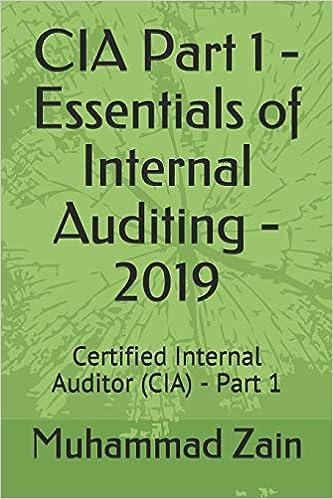Answered step by step
Verified Expert Solution
Question
1 Approved Answer
I only need the ones that are wrong. thank you. Measures of liquidity, Solvency, and Profitability The comparative financial statements of Marshall Inc. are as






I only need the ones that are wrong. thank you.
Measures of liquidity, Solvency, and Profitability The comparative financial statements of Marshall Inc. are as follows. The market price of Marshall common stock was 62 on December 31, 20Y2. Marshall Inc. Comparative Retained Earnings Statement For the Years Ended December 31, 20Y2 and 20Y1 20Y1 20Y2 Retained earnings, January 1 Net income Total Dividends $3,598,900 840,000 $4,438,900 3,035,100 621,600 3,656,700 10,500 47,300 57,800 $4,381,100 $10,500 47,300 57,800 $3,598,900 On preferred stock On common stock Total dividends Retained earnings, December 31 Marshall Inc. Comparative Income Statement For the Years Ended December 31, 20Y2 and 20Y1 20Y2 20Y1 4,686,570 1,853,620 Sales Cost of goods sold Gross profit $5,086,640 2,014,800 $3,071,840 2,832,950 Marshall Inc. Comparative Income Statement For the Years Ended December 31, 20Y2 and 20Y1 20Y1 20Y2 5,086,640 2,014,800 3,071,840 s963,940 821,130 $1,785,070 $1,286,770 67,730 $1,354,500 400,000 $ 954,500 114,500 $ 840,000 $ 4,686,570 1,853,620 $ 2,832,950 $1,236,380 726,130 $1,962,510 870,440 55,560 $926,000 220,000 $ 706,000 84,400 $621,600 Sales Cost of goods sold Gross profit Selling expenses Administrative expenses Total operating expenses Income from operations Other revenue Other expense (interest) Income before income tax Income tax expense Net income Marshall Inc. Comparative Balance Sheet December 31, 20Y2 and 20Y1 20Y2 20Y1 Marshall Inc. Comparative Balance Sheet December 31, 20Y2 and 20Y1 20Y2 20Y1 Assets Current assets 779,790 1,292,210 949,000 584,000 155,960 $3,760,960 462,116 4,950,000 $9,173,076 1,170,330 1,771,310 1,007,400 759,200 221,411 4,929,651 2,151,659 5,500,000 $12,581,310 Cash Marketable securities Accounts receivable (net) Inventories Prepaid expenses Total current assets Long-term investments Property, plant, and equipment (net) Total assets Liabilities Current liabilities $1,590,210 $ 1,214,176 Long-term liabilities: 2,250,000 2,750,000 5,000,000 6,590,210 Mortgage note payable, 896 Bonds payable, 890 2,750,000 $2,750,000 $3,964,176 Total long-term liabilities Total liabilities Stockholders Equity otal liabilities Stockholders' Equity 750,000 860,000 4,381,100 5,991,100 $12,581,310 $ 750,000 860,000 3,598,900 5,208,900 $9,173,076 Preferred $0.70 stock, $50 par Common stock, $10 par Retained earnings Total stockholders' equity Total liabilities and stockholders' equity Required: Determine the following measures for 20Y2, rounding to one decimal place, except for dollar amounts, which should be rounded to the nearest cent. Use the rounded answer of the requirement for subsequent requirement, if required. Assume 365 days a year 1. Working capital 2. Current ratio 3. Quick ratio 4. Accounts receivable turnover 5. Number of days' sales in receivables 6. Inventory turnover 7. Number of days' sales in inventory 8. Ratlo of fixed assets to long-term liabilitles 9. Ratio of liabilities to stockholders' equity 10. Times interest earned 11. Asset turnover 12. Return on total assets 3,339,441 3.1 2.5 5.2 70.2days 121.7 days 1.1 1.1 5.3 X 0.5 10 X % 70.2 days 5. Number of days' sales in receivables 6. Inventory turnover 7. Number of days' sales in inventory 8. Ratio of fixed assets to long-term liabilities 9. Ratio of liabilities to stockholders' equity 10. Times interest earned 3 121.7 days 1.1 1.1 5.3 X 0.5 11. Asset turnover 10 X % 52.2 x % 96.5 x % 12. Return on total assets 13. Return on stockholders' equity 14. Return on common stockholders' equity 15. Earnings per share on common stock 16. Price-earnings ratio 17. Dividends per share of common stock 18. Dividend yield 9.65 6.4 0.55 0.9 % Feedback Check My Work 1. Subtract current liabilities from current assets. 2. Divide current assets by current liabilities. 3. Divide quick assets by current liabilities. Quick assets are cash, temporary investments, and receivables 4. Divide sales by average accounts receivable. Average Accounts receivable (Beginning Net Accounts Receivable + Ending Net Accounts Receivable) 2 3. Divide quick assets by current liabilities. Quick assets are cash, temporary investments, and receivables 4. Divide sales by average accounts receivable. Average Accounts receivable = (Beginning Net Accounts Receivable + Ending Net Accounts Receivable) 2 5. Divide average accounts receivable by average daily sales. Average Accounts receivable- Beginning Net Accounts Receivable + Ending Net Accounts Receivable 2. Average daily sales are sales divided by 365 days 6. Divide cost of goods sold by average inventory. Average Inventory (Beginning Inventories-Ending Inventories) 2. 7. Divide average inventory by average daily cost of goods sold. Average Inventory- (Beginning Inventories+ Ending Inventories)+2 sold is cost of goods sold divided by 365 days. 8. Divide property, plant, and equipment (net) by long-term liabilities. 9.Divide total liabilities by total stockholders' equity. 10. Divide the sum of income before income tax plus interest expense by interest expense. 11. Divide sales by average total assets. Average total assets-(Beginning total assets+Ending total assets)+2 12. Divide the sum of net income plus interest expense by average total assets. Average total assets (Beginning total assets + Ending total assets) 2. 13. Divide net income by average total stockholders' equity Average total stockholders' equity = Beginning total stockholders' equity + Ending total stockholders' equity) + 2. 14. Divide net income minus preferred dividends from the retained earnings statement by average common stockholders' equity. Common stockholders' equity Common stock + Retained earnings Average common stockholders' equity Beginning common stockholders' equity + Ending common stockholders' equity 2 15. Divide net income minus preferred dividends from the retained earnings statement by common shares outstanding (common stock+ par value). 16. Divide common market share price by common earnings per share (use answer from requirement 15) 17. Divide common dividends (from Retained Earnings Statement) by common shares outstanding (common stock par value). 18. Divide common dividends per share (use answer from requirement 17) by market share price ) Average daily cost of goodsStep by Step Solution
There are 3 Steps involved in it
Step: 1

Get Instant Access to Expert-Tailored Solutions
See step-by-step solutions with expert insights and AI powered tools for academic success
Step: 2

Step: 3

Ace Your Homework with AI
Get the answers you need in no time with our AI-driven, step-by-step assistance
Get Started


